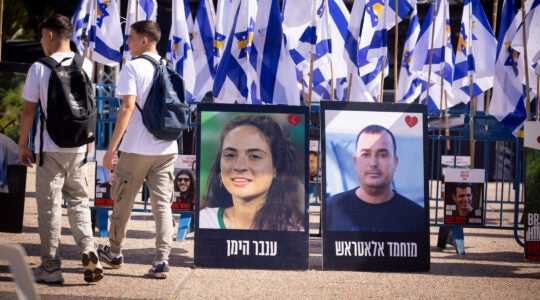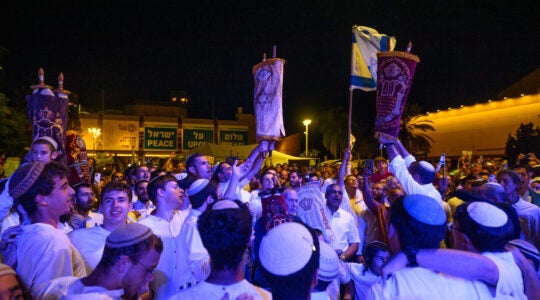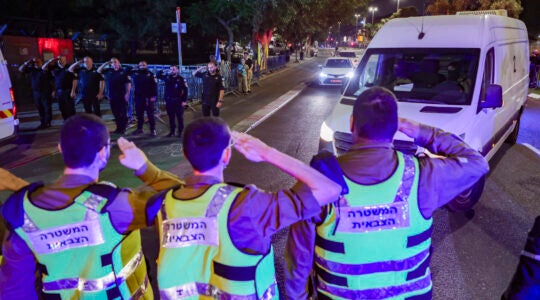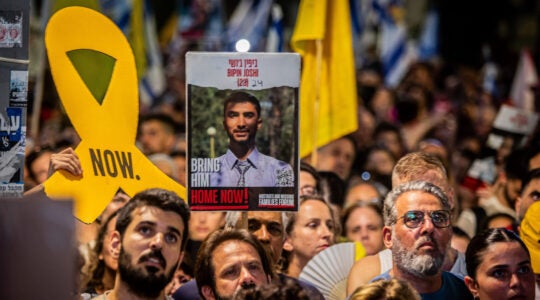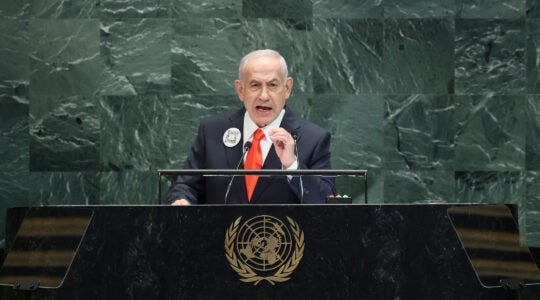
A tree growing in the Carmel Forest surrounded by protective casing. The Jewish National Fund is planting trees in the area destroyed by the 2010 Carmel Fire, Jan. 2013. (Ben Sales)

Visitors at the memorial to the victims of the 2010 Carmel Fire in Beit Oren, Israel, reading the wall displaying the names of the deceased, Jan. 2013. (Ben Sales)

A view of part of the scorched area of the Carmel Forest, burned in the 2010 Carmel Fire, with an intact area of the forest in the background, Jan. 2013. (Ben Sales)
CARMEL FOREST, Israel (JTA) — The rabbi’s yarmulke fluttered in the wind, his hand holding it to his head, as he recited El Malei Rachamim, the traditional prayer for the deceased.
In front of him were 50 guards from a nearby prison. Behind him, a wall displayed the names of 44 prison service cadets, teachers, police and firefighters who died when a bus carrying the cadets was engulfed by the largest fire in Israel’s history.
The Carmel Fire started on Dec. 2, 2010 and burned for five days, destroying 6,000 acres of northern Israel’s expansive Carmel Forest. In June, the government released a harsh report in criticizing the conduct of its agencies during the fire.
But even as the country continues to mourn the fire’s dead, the forest is being reborn. Trees are regenerating on their own, new species are being planted, protection against future fires is expanding and hikers are returning to once-charred trails. Israel’s fire services also have grown.
On Jan. 18, for the first time since the fire, families will come to plant trees in the forest in advance of Tu b’Shvat, the Jewish New Year for trees.
Today, the area of the fire looks like a giant bald spot in the middle of a dense forest of pines and oaks. Rolling hills, bare of trees, stand encircled by verdant slopes where the ground is hardly visible. On the empty hills, a few solitary trees have survived. Many of them are black on one side and green on the other, partial victims of the fire.
Closer to the ground are rows of light brown tubes about two feet tall made from a plastic material that looks like cardboard. A few leaves peek from underneath. These are the oaks, carob trees and Jerusalem pines planted by the Jewish National Fund, a quasi-governmental organization that helps develop Israel’s land and nature and which is famous for planting trees across the country.
“Usually, a natural forest you leave to nature,” said Omri Boneh, director of Israel’s northern region for JNF. “But in the specific environment of the Carmel, if we don’t intervene, it will lead to a very dense forest with lower biodiversity and with great vulnerability to a future forest fire.”
JNF sits on a committee to rehabilitate the forest along with Israel’s Nature and Parks Authority, the Environmental Protection Ministry and the Agriculture Ministry. Formed in 2011, the committee has been able to accelerate its work after being granted a nearly $15 million budget last year.
The committee hopes to turn tragedy into opportunity. Its team wants to let the forest regenerate on its own but will intervene in a few ways: thinning out the pine regrowth to prevent future fires from spreading quickly, introducing new tree species and rebuilding hiking trails.
“We’re changing the nature of the character of the flora,” said Guy Ayalon, the Nature and Parks Authority’s northern Israel director. “When they’re dense, they are a risk for a fire like the one we saw.”
The authority plans to introduce more Jerusalem pines as well as oak, almond, olive and carob trees — all native to Israel and thus, explains Ayalon, in better sync with the environment. Boneh said that a wider range of trees will attract a wider range of wildlife to the forest.
Both men expect the rehabilitation process to take at least 10 years, by which time the newly planted trees will grow tall and thick. In the meantime, Ayalon hopes the government will keep funding the project.
“Forest care needs to happen all the time, and Israel needs to know how to invest in it,” he said. “If you do adequate prevention, fires will be rarer and smaller.”
The government, meanwhile, has invested in its fire prevention capabilities, which drew heavy criticism in the Carmel Fire’s wake. It has united the local fire stations under a new national umbrella agency and invested nearly $100 million in fire equipment and personnel. The funds have paid for new gear for firefighters, an expanded fleet of trucks and, for the first time, a fleet of eight planes dedicated to fire prevention. Each plane can spray nearly 80,000 gallons of water.
Still, Fire and Rescue Service spokesman Yoram Levy said, Israel has a long way to go. He said the goal was to be able to respond to fires within nine minutes. Now the average is 14.
The government has promised the service an additional $268 million over five years. But with Israel facing a $10 billion budget deficit this year, Levy suspects that may turn out to be an empty promise.
“Now we’re talking about budget cuts, and [members of Knesset] were saying they want to cut us,” he told JTA. “They’re definitely going to try.”
Boneh is happy to see Israel’s fire services improve, but says that in the end preventing fires like the Carmel is near impossible.
“It doesn’t matter what we do,” he said. “On Dec. 2 [2010], there hadn’t been significant rain, the dryness of the soil was extreme and there was wind. If there’s a fire, it’ll get to that size.”
For now, though, Boneh and Ayalon hope to rebuild the forest they saw burn — and to see it last.
“Planting a tree in Israel testifies to our roots in our homeland,” Ayalon said. “But you have to make sure that the trees are appropriate to their surroundings.”
JTA has documented Jewish history in real-time for over a century. Keep our journalism strong by joining us in supporting independent, award-winning reporting.
